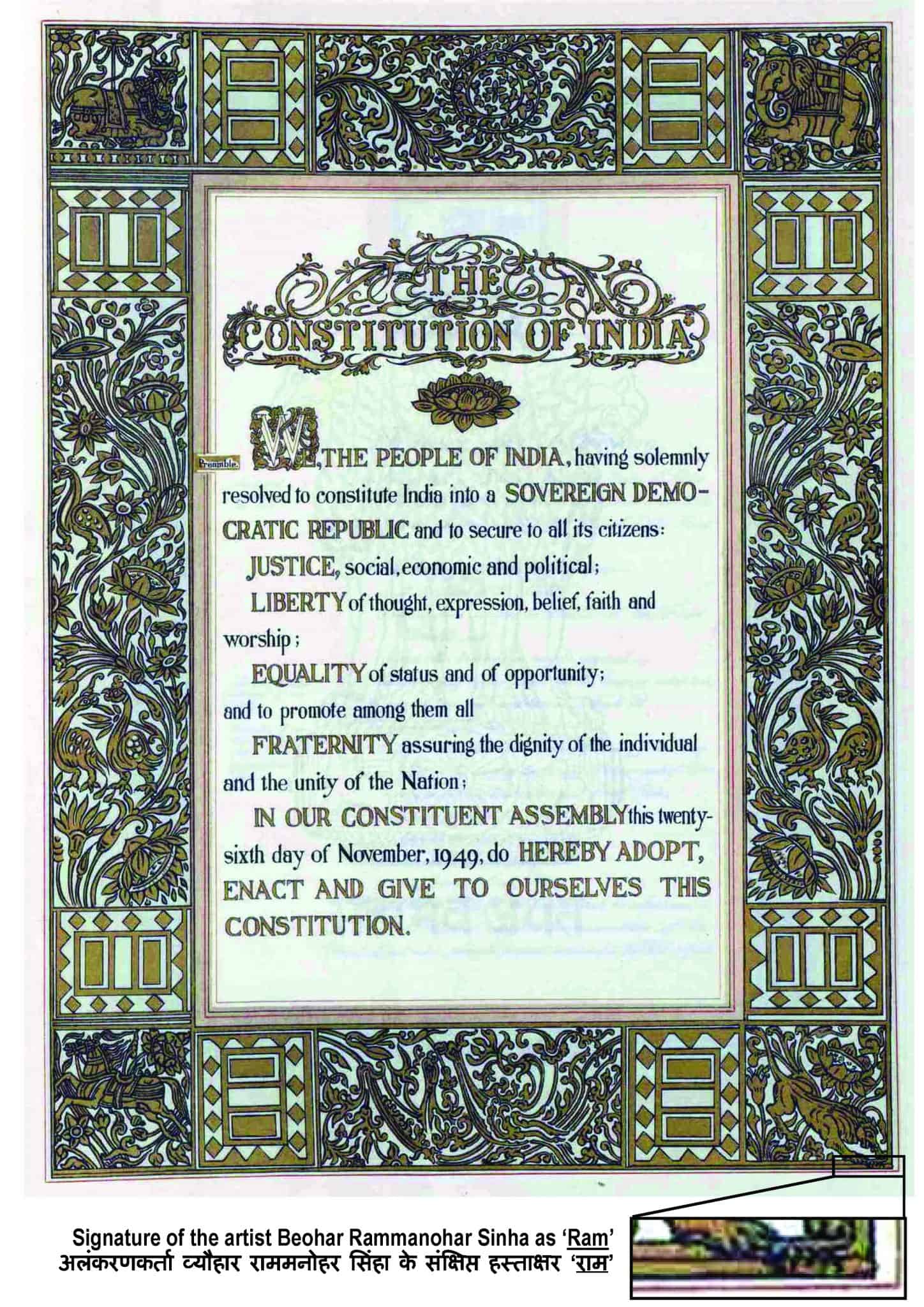AUTHORED BY: MR. PRANAV KAUSHAL, B.A.LL.B STUDENT AT BAHRA UNIVERSITY SHIMLA HILLS. MR. PRANAV KAUSHAL HAS SECURED 1ST PRIZE IN LAW AUDIENCE'S NATIONAL ONLINE ARTICLE WRITING COMPETITION ON CONSTITUTION DAY 2018.
PROLOGUE:
“A State without a Constitution would never be called a State but a regime of anarchy”- Jellineck
It is unimaginable to think the Modern State without a ‘Constitution’. A Constitution has always been considered as the vital necessity which determines the Powers and relationship between the citizens of a country and between ‘Governors and Governed’. A democratic system cannot be governed without powers. The Constitution of a country must seek to establish the fundamental rights, apex organs of the government, structure, composition and powers of the administration, the relationship of the organs with one another and to regulate more effectively the functioning of these organs with the citizens of the country.[1] Because of these aspects, the Constitution of the country is always been considered to be the supreme law of the land. In simple terms, Constitution may be defined as the body of rules and the maxims in accordance with which the powers of the sovereignty are habitually defined and exercised.[2] The Constitution is the basic law of the country and hence it is truly said that as the time is not static, similarly the Constitution amends as per the needs of the masses just same as the life of a nation is dynamic. Thus, the Constitution deals with such questions as what are the powers and functions of the different organs of the government. What is the relationship between different organs of the government among themselves? Does the Constitution provide any mechanism to secure the rights of the citizens? The ‘Constitution’ provides an answer to all these questions. Therefore, Constitution means a document which has a legal sanctity and sets out the framework and the principal functions of the organs of the government of a particular state and declares the principal governing the operations of those organs.[3] Constitutional Law, on the other hand, means the rule which governs and regulates the structure of the principal organs of the government and their relationship with each other and determines their principal functions. The rules consist of both legal rules in strict sense and usages, which is commonly called conventions which without being enacted are accepted as binding by all who are concerned in the government.[4] The Constitution is the very basis on which the law of the country gains pride and sanctity. The Constitution is the living document, whose interpretation may change as time and circumstance changes.[5]
INTRODUCTION- DEFINING THE CONTEXT:
The Constitution of India came into force on 26th January 1950, announcing the birth of new Sovereign, Socialist, Secular and Democratic Republic India to the entire world. Constitution of India is the Supreme Lex, which reflects upon the struggle and aspirations of the people of the country which was subjected against the oppressive rule of Colonial empire for more than 350 years. The Constitution of India is well known as the grundnorm of the country as all the other existing laws derives its force from the constitution itself. It almost took two years, eleven months and eighteen days to complete the historic task of drafting the World’s lengthiest, bulkiest and most detailed Constitution of the world. The constitution of India was adopted on 26th November 1949 and came into force on 26th January 1950. As the Constitution of India is an elaborative document which contains at its commencement 395 Articles, 22 Parts and 12 schedules. The Constitution of India incorporates the title of “one of the best features of the constitution” across the world. The Constitution of India, on the other, hand has been labelled with the tag of “Borrowed Constitution”. During the Constituent Assembly, Dr. Bhim Rao Ambedkar stated that “there is nothing to be ashamed of in borrowing what suits us the best”.
THE PREAMBLE: SOURCE OF THE CONSTITUTION:
The preamble to the Constitution of India is an introductory statement that sets out the guiding principles and purpose of the social document. Every Constitution whether it is written or unwritten has the ‘Preamble’ associated with it. It sets out the ideals, objectives and goals which the framers of the Constitution intend to achieve through that social document.[6] Therefore, this Preamble many times has been referred to as “Key to open the mind of the makers of the Constitution which may show general purposes for which they made the Constitution.[7] For this reason, the Preamble is considered as a legitimate aid in the interpretation of the provisions of the Constitution and Preamble of the Constitution stands on the equal footing as the Preamble of the Act.[8] The Preamble also indicates the source from which the Constitution comes viz. ‘People of India’. This is ordained by the people of India through their representative conscience. The Preamble to the Constitution of India declares clearly that it is the ‘People of India’ who have adopted, enacted and given to themselves this Constitution. The Preamble embodies in itself the importance, objectives, purposes and the policies underlying in its provisions apart from the basic character of the state which came into existence to fulfil the aspirations of the citizens of India.
India being a Welfare State is committed to the maximum welfare and development for its citizens.
The Preamble of the Constitution of India States,
“WE THE PEOPLE OF INDIA, having solemnly resolved to constitute India into a SOVEREIGN SOCIALIST SECULAR DEMOCRATIC REPUBLIC and to secure to all citizens;
JUSTICE, Social, Economic & Political;
LIBERTY of thoughts, expression, belief, faith and worship;
EQUALITY of status and of opportunity and to promote among them all;
FRATERNITY assuring the dignity of the individuals and the unity and integrity of the nation;
IN OUR CONSTITUENT ASSEMBLY this twenty-six day of November 1949, do hereby ADOPT, ENACT AND GIVE TO OURSELVES THIS CONSTITUTION.
The Preamble of the Constitution of India sets out the aims and aspirations for the citizens of India and these aims and aspirations have been translated into various provisions of the Constitution. The main objective of the Constitution is to constitute India into sovereign, socialist, secular and democratic republic nation and to secure to all its citizens’ justice, liberty, equality and fraternity. The ultimate and the foremost aim of the constitution framers is to have a welfare state and an egalitarian society preserving and protecting the aspirations of the citizens of India who sacrificed their lives in order to make India free from British Rule. The Constitution of India reflects the sense of all essential mandates which is important for every human being to survive in a man-made society with dignity and personal liberty. This is evident from the Preamble[9] and reliance given by the makers of the Constitution to the Fundamental Rights, Directive Principles of State Policy. It has been rightly opined that the Fundamental rights as well as the Directive principles of the State policy explain the concepts of the objectives enshrined in the Preamble[10] and could be characterized as the essential elements constituting the conscience of the Constitution of India.[11] The picture of the Indian Constitution gives us the right perspective for the scope of the objectives enshrined in the Preamble for the aspirations of the nation. The objectives are sought to be achieved by the Constitution echoes in its Preamble.[12] The Supreme Court in the case of Golak Nath v. State of Punjab[13] observed that, “It is an error to view our Constitution as it was merely an organisational document by which People of India established structure and mechanism to form the government. Our Constitution is intended to be much more because our Constitution is a Social Document in which the relationship of the society to the individual and of the government has been clearly defined along with the rights of minorities and backward classes are also laid down. The Social document is headed by the Preamble which lays down emphasis on the aspiration for the citizens of India. The Constitution of India is historically called as Socio-Legal document embracing all the aspirations of the people belonging to a different multifaceted heterogeneous society, which is undoubted, is the spirit of people of India. The aim of this grundnorm is to satisfy the needs as has been mentioned in the Preamble of the Constitution which is further mentioned in the Articles of the Constitution. The ultimate goal is that of “securing the dignity of the individual as well as the integrity of the nation. Apart from the fact that the Preamble provides to the people of India who have adopted and enacted to give themselves the constitution but also provides that the binding force of the Constitution is the sovereign will of people of India. Lord Halsbury said about the two proposition, firstly that a Preamble may afford useful light as to what the Statute intents to achieve, secondly, that if an enactment is itself clear and unambiguous , no Preamble can cut down the enactment.[14] If at any stage people are of the opinion that Constitution is not serving the needs of the society, for what purpose it has been enacted, they may set in motion the machinery or the procedure which provides for a system suited to aims and aspirations of people. It may be rightly observed that the word ‘Sovereignty’ is not only restricted to the Parliament, however it is the people who have given the constitution. Thus the foremost and ultimate source of the Constitution is the People of India from whom the Constitution receives its ultimate sanction.
UTILITY OF THE PREAMBLE TO THE CONSTITUTION OF INDIA:
The Preamble to the Constitution of India represents the quintessence of the ideals, philosophy, soul and spirit of the entire objectives enshrined in the constitution. It had the stamp of “Deep and deep deliberations”, and is “marked with the precisions”; it was “an epitome” of the board features of the constitution which were an amplifications or concretizations of the concepts sets out in the Preamble.[15] The preamble not only grants power but also gives directions for the purpose of the preservation of Constitutional objects. The Utility of Preamble is as follows:
- It contains the enacting clause to bring the constitution into force.
- Indicates the source of the constitution
- Declare the type of government and polity sought to be established in the democratic country.
- A brief statement of the objectives of the constitution as per the needs of the society.
- It serves to the People of India to adhere by the ideals enshrined in the preamble.
- It is a key to unlock the treasures provided in the highest ambit of the social document.
- The Supreme Court of India pointed out the utility of the Preamble for the legal interpretations of the Constitution.
Therefore what Preamble to the Constitution of India signifies is that in a democratic setup the ultimate powers rests in the hands of the people. All powers emanate from the people and political system be accountable and responsible to the people of India.
SOVEREIGN:
The word ‘Sovereign’ means the ‘Supreme or Independence’. India is both externally and internally sovereign i.e. externally free form the control of the foreign power and influence, internally the State of India has a free government which is elected by the people and the elected government makes laws that govern the people. The term ‘Sovereignty’ has been considered as one of the basic structures of the Constitution of India. Hence, the citizens of India enjoy the sovereign power to elect their representatives in elections held for the Parliament, the state legislature and for local bodies as well. People of India have the supreme rights to take decisions on their internal and external matters. No foreign power can dictate the government of India. All people are free to work according to their choice within reasonable restrictions.
SOCIALIST:
The word socialist has been added to the Preamble by the 42nd Amendment during the emergency in the year 1976. The word ‘Socialist’ implies social, political and economic equality. The context of social equality means the absence of discrimination on the grounds of caste, creed, colour, sex, religion and language. Under Social equality, each and every one has equal status and opportunity. Whereas, economic equality means that the government of India will endeavour to make the distribution of wealth more equal and provide a reasonable standard of living. The word socialist emphasised a commitment towards the formation of a welfare state.
SECULAR:
The word ‘Secular’ was also added to the Preamble by the 42nd Amendment during the emergency in the year 1976. Citizens of India have complete freedom to follow any religion and the state would not be having any official religion. Moreover, in the matter of religion the State would be neutral. The Government of India should treat all religions with equal respect and honour.
DEMOCRATIC:
The opening lines of the Preamble “We, the people of India” and the last line “Give to ourselves this Constitution” clearly indicate the democratic aspect and spirit involved in the Constitution. India is a democratic country, and people of India are free to elect their representative by the system of, “One person one vote”. Every citizen of India enjoys the right to vote without any discrimination.
REPUBLIC:
The word “Republic” as opposed to the word ‘Monarch’, in which the head of the state is appointed on hereditary basis for a lifetime until he abdicates from the throne, whereas the democratic republic is an entity in which the head of the state is elected directly or directly by the people for a fixed tenure.
OBJECTIVES:
The four objectives circumscribed in the Preamble namely as Justice, Liberty, Equality and Fraternity. The essence of the word “Justice” is for the attainment of the common good. It embraces the entire social, economic and political atmosphere of human activity. The term “liberty” is merely a positive concept. It signifies not only the absence of any arbitrary restraint and restriction on the freedom of individual action but also creates a condition in which all human beings can develop themselves to the fullest extent by providing equal opportunities of status. The word “Equality” on the other hand signifies equality of status and availability of opportunities to everyone so as to develop their potential capabilities. The word “Fraternity signifies the spirit of brotherhood in the Preamble. India is a Secular State, the unity and integrity of the Nation can only be preserved only through the spirit of brotherhood that pervades the entire nation, irrespective of any consideration.
The Preamble of the Constitution of India is amongst the best-drafted constitutions across the world. Both the ideas and expressions embodied in the Constitution is unique and different. It embodies to build an independent nation which will ensure the triumph of Justice, liberty, equality and fraternity. Therefore the Preamble has been considered as “Jewel set” in the constitution.
SALIENT FEATURES OF THE CONSTITUTION OF INDIA:
- WRITTEN CONSTITUTION: Indian Constitution is a written Constitution. It almost took two years, eleven months and eighteen days for drafting it. It is one of the lengthiest, bulkiest and most detailed Constitutions in the world. At its commencement, it contains 395 Articles, 12 schedules and 22 Parts.
- LENGTHIEST, BULKIEST AND MOST DETAILED CONSTITUTION: The Indian Constitution is the lengthiest and most detailed Constitutions in the world and this is due to inclusion of various elaborative provisions regarding centre and state relationship, concepts like Fundamental rights, Directive Principles of State Policy, Fundamental duties, provisions safeguarding the interest of minority community and backward classes.
- PARTLY RIGID AND PARTLY FLEXIBLE: The Constitution of India is a mixture of partly rigid and partly flexible. The Constitution may be called as partly fixed and partly rigid on the basis of the amending procedures. Indian Constitution deals to have both these features.
- SOCIALIST STATE: The term “Socialist” was not there at the commencement of the Constitution. But this word was added by the 42nd Amendment Act in the year 1976. The word “Socialism” means that some form of ownership of the means of production and distribution by the state. The Supreme Court in a number of its decisions referred to the concept of socialism and has used this concept along with the Directive Principles of State Policy.[16] The word Socialist has also been deduced into the Fundamental right to equal pay for equal work and compassionate appointment.[17]
- SECULAR STATE: India is a country with many religions and religious beliefs, but the Constitution of India provides India to be a secular state. The term Secularism means that:
- The state has no official religion of its own
- Citizens of India are free to follow any region of their choice
- No discrimination is to be made by the state on the account of religion
- WELFARE STATE: India is a welfare state and the Constitution of India incorporates the principles of social justice and the concept of welfare state, whose ultimate objective is to serve the needs and fulfil the aspirations of the citizens of India.
- FEDERAL-STATE WITH UNITARY BASIS: the Constitution of India is quasi-federal in nature. It establishes the dual polity and a two-tier government system i.e. one central government and state government for each state.
- SINGLE CITIZENSHIP: All the Citizens of India irrespective of their domicile enjoys single citizenship of India so as to foster the bond of social and political unity among the people who belong from different and various grounds.
- INDEPENDENCE OF JUDICIARY: The most remarkable and most noted feature of the Indian Constitution is the role of Judiciary which is entrusted with a function to act as “Guardian and watchdog” for the protection of constitutional values.
- FUNDAMENTAL RIGHTS, DIRECTIVE PRINCIPLES OF STATE POLICY AND FUNDAMENTAL DUTIES: Part III of Indian Constitution deals with fundamental rights which are the basic rights which are being provided to each and every citizen of India irrespective of any discrimination. Whereas Part IV of the Indian Constitution deals with the Directive Principles of State policy which have been considered as fundamental in the governance of the country although these Directive principles are non-justifiable. Fundamental Duties have been incorporated in the Indian Constitution by 42nd Amendment Act 1976 which imposes a duty on the citizens of India to perform certain obligations i.e. duties.
- EMERGENCY PROVISIONS: Centre has the power to take control of the state in the following three situations
- An Act of foreign aggression or internal armed rebellion (Article 352).
- Failure of the Constitutional Machinery of the State (Article 356).
- Financial Emergency (Article 360).
In all the above cases, the elected government can lose control over the state and centre rule can be established in those states.
- PARLIAMENTARY DEMOCRACY: India has adopted the Parliamentary form of government which has been adopted from the British system. In a parliamentary form of democracy, there is a close relationship between the two wings of the government i.e. Legislature and Executive. The President of India is the Constitutional head of the State, but in practice, the council of ministers headed by the Prime Minister really exercises these powers. The President acts on the advice of the Prime Minister and Council of Ministers.
CONCLUSION:
The most beautiful thing that has been provided by the Constitution to the citizens of India is the “Life”. The word life has its significance since the beginning of human civilization and it can be seen in the ancient times that the prime concern of the King is to protect the life of the people. With the advent of the concept of the welfare state “Protection of life” has been guaranteed in the constitution in different forms as the most important natural rights, human rights, basic rights, fundamental rights or constitutional rights. Every person requires certain essential rights for their survival without which the life would be impossible to live. Therefore, for me, the Constitution of India is “HARBINGER OF LIFE”
[1] Wade & Phillips, Constitution and Administration Law, (IX edition) 1987, p 5.
[2] Thomas M. Cooley “The General Principles of Constitutional Law in United States of America” 4th Edition, p.19.
[3] Wade and Phillips “Constitutional Law, (IV Edition), p.1.
[4] J.N Pandey, “Constitutional Law” (51st Edition) p.1.
[5] Constituent Assembly Debates, Volume IX, 26th November 1949.
[6] “The Preamble contains in a nutshell its ideals and aspirations”, Subba Rao, C.J in I.C Golak Nathv. State of Punjab, (1967) 2 SCR 762.
[7] Berubari v. Union and Exchange of Enclaves, (1960) 3 SCR 250.
[8] Maxwell, “Interpretation of Statutes, 12th edition, 1969, 6-9.
[9] See, The Constitution of India, Preamble….. “WE THE PEOPLE OF INDIA, having solemnly resolved to constitute India into a SOVEREIGN SOCIALIST SECULAR DEMOCRATIC REPUBLIC…”
[10] D.D Basu, “Commentaries on the Constitution of India”, Volume E (1981), p 94.
[11] Granville Austin, “The Constitution of India”(1966) p.50.
[12] R.G Chaturvadi “Natural and Social justice” 2nd Edition 1975 p .465.
[13] Golak Nath v. State of Punjab, AIR 1967 SC 1643.
[14] Powell v. Kempton Park Race Course, 1899 AC 143 at 153.
[15] Justice Madhlokar in case of Sajjan Singh v. State of Rajasthan, (1965) SCR (1) 933.
[16] D.S Nakara v. Union of India, (1983) 1 SCC 305.
[17] Balbir Kaur v. Steel Authority of India, AIR 2000 SC 1596.



